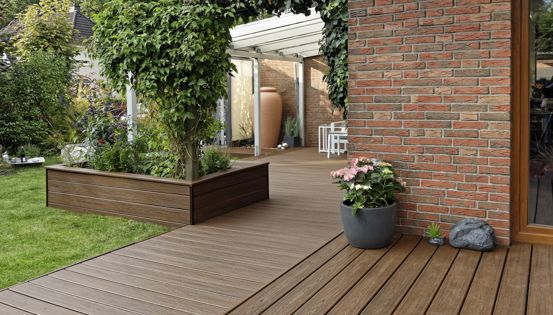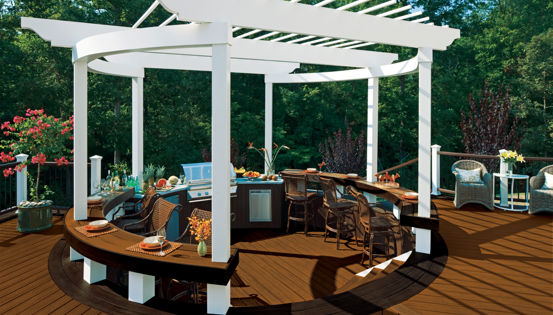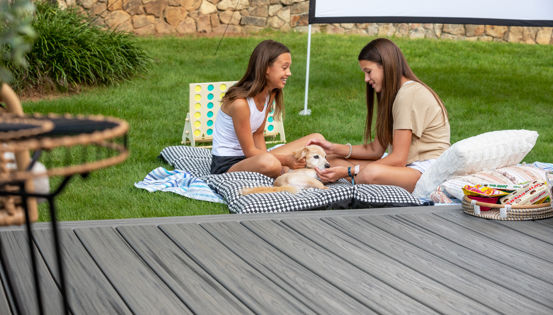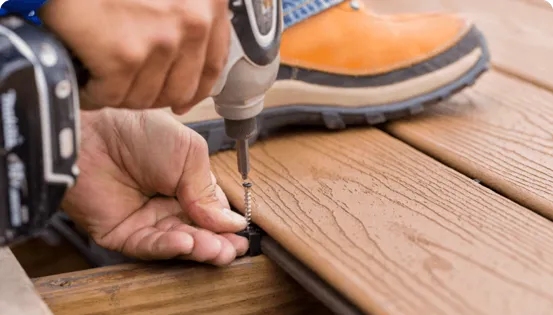Installing Cable Deck Railings
If you’ve decided on cable railing for your deck, you have choices to make among various methods and products. Whether you shop for all the components and build one from scratch, or order a kit that includes all the parts, this article will explore the materials, tools, and skill level you need, and help you avoid time-consuming and expensive mistakes.
What is a Cable Deck Railing?
Instead of traditional balusters or other infill panels, a cable deck railing features stainless steel cables that are tensioned between two posts. The cables are most often strung horizontally but can also be vertical. This article will focus on horizontal cables.
What Are the Pros and Cons of Cable Deck Railing?
Cable deck railing has gained popularity for its sleek appearance and practical benefits, but it's not without its drawbacks. Understanding the pros and cons can help you decide if this modern railing option is the right choice for your deck.
PROS:
- Low Maintenance: Cable railings are made with corrosion-resistant stainless steel cables, and when paired with metal posts, ensure durability and ease of care. Even a railing that’s a combination of wood posts and cable railing requires far less upkeep than a full wood railing.
- Modern Design: Sleek and elegant, cable systems have a minimalist style that enhances your deck's natural beauty without overshadowing it.
- Easy to install: Kits like Trex Signature X-Series allow for quick and easy installation.
Unobstructed Views: Best of all, the thin cables provide a much more open view than wood balusters do, letting you fully enjoy your surroundings.
CONS:
- Modern Design: A minimalist style may not be appropriate for all deck designs.
- Framing requirements: Because the tension on the posts can be considerable, the posts need to be rigorously reinforced in order to keep them plumb.
Cost: Cable can be one of the more expensive railing options.
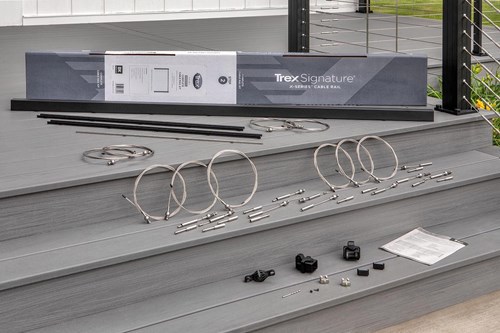
What Parts Are Needed to Build a Cable Railing?
Cable railing kits, such as the Signature® X-Series™ Cable Railing from Trex, include most of the parts and some of the tools you’ll need. Kits can be more expensive, but they’ll save you a lot of time, hassle and return trips to the home center for supplies. If you’re building your cable railing from scratch, you’ll need to gather all the parts yourself. Here’s a list of the basic supplies:
- Cable: For residential purposes, you’ll usually use cable that’s 1/8 in. to 1/4 in. in diameter. A typical railing has 11 to 13 strands of cable, depending on the spacing.
- Anchor posts to secure the cable to: Typically, self-assembled railing will use wood posts, as opposed to the metal posts usually supplied with kits.
- Intermediate posts: These posts in between the anchor posts reduce cable deflection.
- Post caps: Caps can prolong the life of wood posts. They can also be used to add lighting or as a decorative element.
- Cap rail: The cap rail (sometimes called “top rail”) holds the post tops apart so you can get proper cable tension without pulling the posts out of plumb.
- Bolts, nuts, and washers: These fasteners are used to attach the wood posts to deck framing members.
- Post blocking material: This will make the post/framing connection more solid.
Turnbuckles, railing swage, threaded studs, and other cable tensioning systems: These vary by brand and are available in configurations that allow you to either connect the cables to the front or back surface of a post.
What Tools Are Needed to Build a Cable Railing?
Building a cable deck railing requires precision, and having the right tools ensures your project goes smoothly. Some tools are essential for accurate measurements and cuts, while others are specialized for working with cables and tensioning hardware. Here’s an overview of the tools you’ll need to tackle the job efficiently and safely:
- Tape measure
- Marking tools like pencils
- Squares for accurate layout and cutting lines
- Drills/drivers for drilling holes in wood posts and driving screws
- Drill bits to fasten the posts and to drill the holes in the posts for the cables. Keep extra on hand because you’re likely to break or dull a few, especially if you’re using a particularly hard wood, such as ipe
- Miter and/or circular saw for accurately cutting parts to length
- Level to ensure the posts are installed plumb
- Ladder for accessing hard-to-reach areas
- Drilling jigs for accurate placement of cable holes in wood posts. These will need to be custom made
- Steel cable cutter for cutting cables to length
- Crimper for crimping the threaded cable studs or tensioning hardware onto the cable ends (depends on the type of tensioning system)
- Wrenches to fasten the posts and for tensioning cables. Kits will likely include these tensioning tools
- Cable tension measuring device (optional) for ensuring proper tension on cables (more on this below)
Safety glasses and hearing protection for cutting
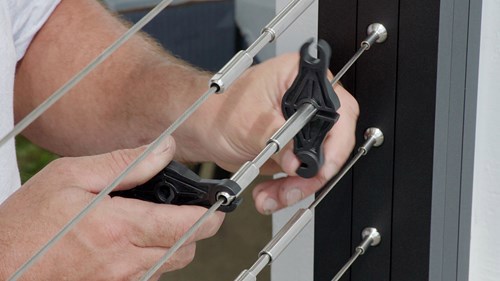
How Tight Do the Cables Need to Be on a Cable Railing?
You can buy devices to measure cable tension, but they’re expensive and unnecessary. Building code mandates that a 4-in. sphere should not be able to pass between any two cables or between the bottom cable and the decking. In order to take cable deflection into account, cables are spaced closer together than 4 in. If you are concerned about the ability of your posts to handle the substantial loads of highly tensioned cables, you can space your cables closer together, so each one won’t need to be so tight. Also, keep in mind that over time, cables will stretch, so you should check them once a year and retighten as needed.
How to Tighten Cables on a Railing
Several different types of turnbuckles, swages, and other proprietary cable tightening systems are available. You should only use the specific tools and methods recommended by the manufacturer. If you’re creating your own system with eye hooks or other cable anchoring hardware, you need to make sure the cable doesn’t twist as it’s being tightened. Twisting against the natural lay of the cable can cause the strands to loosen and separate. This compromises the cable’s structural integrity, reducing its strength and load-carrying capacity. No matter what tensioner you use, start tensioning from the middle cable, alternately working your way toward the top and bottom cables. When you’re finished, go back and recheck the center cables.
What is the Maximum Distance Cables Can Span Between Posts?
The maximum distance cables can span between posts depends on several factors, including the strength and material of the posts, the spacing of the cables, and the use of mid-span supports. For decks that are higher off the ground and need to comply with building codes, posts are typically placed closer together to ensure structural integrity and safety. Stronger posts, such as metal or thick wood, allow for greater spacing, while weaker or less rigid materials require closer post placement to maintain the necessary tension in the cables. Additionally, the closer the cables are spaced, and the more mid-span supports are used, the farther the cables can effectively span without sagging or losing tension. Always consult local building codes and manufacturer recommendations to ensure compliance and optimal performance.
Important Cable Railing Installation Do’s and Don’ts
Installing cable railing isn’t particularly difficult, but you need at least basic skills with power tools. You’ll need more skills and tools to build your railing from scratch than you would if you use a kit. Either method can be accomplished alone, but it’s much easier if you have a helper. If you’re building your railing from scratch, consider these important dos and don’ts:
- Make sure your posts are securely anchored to blocking attached to the deck framing.
- Tying the post tops together with a sturdy cap rail is the surest way to prevent the posts from being pulled when you tension the cables.
- Don’t run cables around a corner. Each straight run of cable should be independent, and each straight run will be fastened to the anchor post at both ends.
- Cut cables so that when they’re installed, there’s enough adjustment in the tensioning hardware to achieve proper tension on the cable. Over time, as the cables stretch, you’ll need to retighten them.
- Frayed cables are sometimes difficult or impossible to fit into narrower hardware components, so invest in a high-quality cable cutter that makes clean cuts.
- Cable lag anchors should have both right-hand and left-hand threads. Be sure each run of cable has right-hand threads on one end and left-hand threads on the other. If you don’t, the cable will twist as you tighten it.
- Drill the cable holes after you fasten the posts to the deck.
- Make a drilling jig (a board with the holes predrilled into it), so you can line it up to all the posts and achieve consistent hole locations.
- Drill the jig holes on a drill press, if you have one, to make sure the holes go straight through the wood.
- Drill from both sides of each post to ensure straight, accurate holes.
- For stair railing posts, make a separate drilling jig with angled holes. You can make two jigs, one for the top side of the post and one for the bottom.
Before you design your cable railing system, consult your local building official for guidelines on how posts need to be attached, post spacing, railing height, handrail requirements, cable spacing, and cable deflection limits.
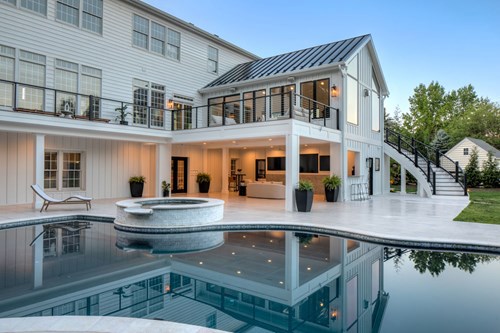
What are the Benefits of a DIY Cable Railing Kit
Kits from manufacturers of premium cable railing systems like Trex are an excellent option, and here’s why:
- Kits require less skill and expertise than building a cable railing from scratch and will be supported by helpful installation instructions.
- You’ll spend less time designing and planning as well as building.
- You won’t spend nearly as much time shopping for supplies or need multiple sources.
- Kits typically require fewer tools.
- If you need help or advice, manufacturers of premium products offer good technical support.
- Manufacturers must engineer and test their products to satisfy building code requirements, and building inspectors will be less skeptical about how they will perform.
- Cable railing kits have corner posts that allow cables to be attached at adjacent corners, which means you don’t need two anchor posts at each corner to maintain consistent spacing from one section to another.
Cable railing kits are usually backed by a warranty; some guarantee products for up to 50 years.
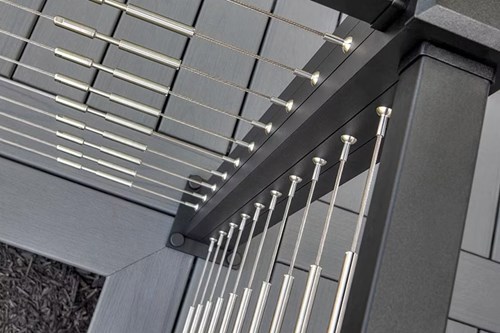
Are all Cable Railing Kits Created Equal?
When it comes to cable railing kits, not all are created equal, and Trex stands out with its thoughtful design. Unlike other kits that require you to install cables directly into the posts, Trex cable railing kits feature innovative post inserts that slide seamlessly into the posts. This not only saves time but also ensures a clean professional-looking result.
See Other Ideas About Deck Railing
- Deck Railing Designs
- Low-Maintenance Composite Deck Railing Options
- How to Install Metal Deck Railings


